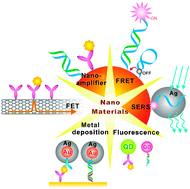Functional nanoprobes for ultrasensitive detection of biomolecules
Abstract
There has been great interest in developing new

* Corresponding authors
a Laboratory of Physical Biology, Shanghai Institute of Applied Physics, Chinese Academy of Sciences, Shanghai 201800, China
b
Key Laboratory of Analytical Chemistry for Life Sciences, MOE, School of Chemistry and Chemical Engineering, Nanjing University, Nanjing 210093, China
E-mail:
fchh@sinap.ac.cn, hychen@nju.edu.cn
There has been great interest in developing new

 Please wait while we load your content...
Something went wrong. Try again?
Please wait while we load your content...
Something went wrong. Try again?
S. Song, Y. Qin, Y. He, Q. Huang, C. Fan and H. Chen, Chem. Soc. Rev., 2010, 39, 4234 DOI: 10.1039/C000682N
To request permission to reproduce material from this article, please go to the Copyright Clearance Center request page.
If you are an author contributing to an RSC publication, you do not need to request permission provided correct acknowledgement is given.
If you are the author of this article, you do not need to request permission to reproduce figures and diagrams provided correct acknowledgement is given. If you want to reproduce the whole article in a third-party publication (excluding your thesis/dissertation for which permission is not required) please go to the Copyright Clearance Center request page.
Read more about how to correctly acknowledge RSC content.
 Fetching data from CrossRef.
Fetching data from CrossRef.
This may take some time to load.
Loading related content
